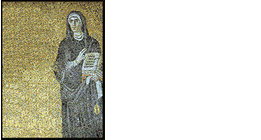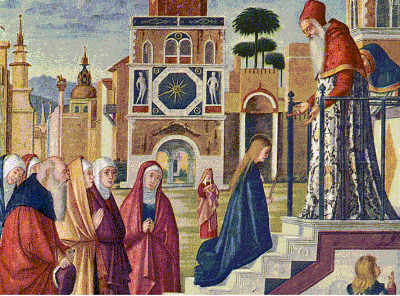 |
|
|
|
| Class
Prep |
|
|
|
Holy Hymen: Vowing Virginity within Marriage

- These last weeks of our course will mostly be devoted to a topic of great
interest in early Christianity, namely asceticism. "Asceticism" comes
from the Greek word askesis, which means training or exercise (like what
you would do in a gym). It is the regular disciplining of the body for a particular
goal— something all you athletes understand well. But the Christian athletes
we will be looking at are more like spiritual athletes, because they are trying
to discipline the body's passions to prepare themselves for a life that would
be entirely spiritual after their deaths.
-
- We have read enough of
Paul to know by now that one of the roots of early Christian asceticism is his
teaching in 1 Corinthians. But one of the other roots, and perhaps the more important
one, is the nature of Jesus himself. As the early church's understanding of Jesus'
divinity grew, so too did the tension between Jesus' human and divine natures.
And the first moment of that tension was Jesus' birth itself.
-
- The
reading in the Gospel of Matthew is the familiar story of Jesus' infancy, which
states that Jesus was born without human intercourse, through the power of the
holy spirit and the assent of the young virgin Mary of Nazareth. Seventy-five
years later, the Infancy Gospel of James went farther. It told not only the story
of Jesus' birth, but also the story of Mary's conception, birth, childhood, and
birthing of Jesus. This gospel didn't make it into the Bible, but neither was
it declared heretical, and in fact in became a very popular resource in Christian
devotion and iconography. In the image above, Carpaccio depicts the scene when
Anna brings Mary to the temple to have her raised by the priests. As you read
this gospel, track the episodes it adds to the canonical gospel picture, and consider
how Mary and Joseph both transgress expected gender roles.
-
- The other
readings are excerpts from later church authors on the value of virginity–by
this point not Mary's as much as normal Christians'. As you read these brief excerpts,
consider the following:
-
-
- Why doesn't Tertullian
want people to remarry after their spouse has died? What arguments does he pose
against remarriage?
- In John Chrysostom's piece, what is "spiritual
marriage"? Can you imagine whether it has any roots in Paul or early Christian
literature? And since John is generally pro-celibacy, why is he so against
this practice? What worries him about it?
-
- Finally, as you read the Castelli piece, consider her central thesis: what was the meaning of virginity for women's sexuality in early Christianity?
-
- You may find yourself today discussing one of two topics in today's Dig Site presentations, depending on whether we have any excavators. One presentation may focus on the cult of the virgin "goddesses" in Ephesus, and the second presentation on the third largest city in the Roman Empire, Chrysostom's Antioch, where spiritual marriages were all the rage.
-
-
- Assigned Readings
-
- Primary: Matthew 1–2; the Infancy Gospel of James
(CG); excerpts from John Chrysostom and Tertullian advocating virginity and recommending against remarriage, pp. 122-6 and 144-55 in Women in the Early Church (Camino)
-
- Secondary: Castelli, "Virginity and Its Meaning for Women's Sexuality in Early Christianity," Journal of Feminist Studies in Religion 2:1 (1986) 61-88 (Camino); online class prep
-
- Slides for Lecture
-
-
- Today's
Author
-
 |
Elizabeth Castelli is Professor and Department Chair of the Department of Religion at Barnard College |
-
-
- Dig Site 10: Artemis & the Virgin Mary in 4th-Century Ephesus (Turkey)
-
- Dig Site 11: Spiritual Marriages in 4th-Century Antioch (Turkey/Syria)
-
-
- Further Reading
-
- Fitzmyer, Joseph A., S.J. "Virginal Conception of Jesus in the
New Testament." Theological Studies 34 (1973) 541-75.
-
- Horner, Timothy J. "Jewish Aspects of the Protoevangelium of James." Journal
of Early Christian Studies 12 (2004) 313-35.
-
- Hunter, David G. "Helvidius, Jovinian, and the Virginity of Mary
in Late Fourth-Century Rome." Journal of Early Christian Studies 93 (1993) 47-71.
-
- Maunder, Chris, ed. The Origins of the Cult of the Virgin Mary. New York: Burns & Oates, 2008.
-
- Undheim, Sissel. Borderline Virginities: Sacred and Secular Virgins in Late Antiquity. New York: Routledge, 2018.
-
-
- Sources
-
- Photograph: The Presentation
of the Virgin, Vittore Carpaccio (1450-1525), from Grace Soileau, "The Presentation
of the Virgin Mary," online, http://www.geocities.com/Heartland/2073/m-presen.htm,
24 February 2006.
-
|
|
|
|
|
|
|
